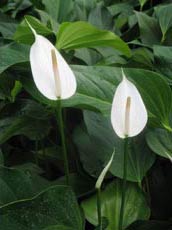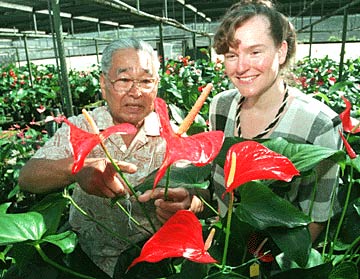Human Flower Project
Saturday, March 03, 2007
Carrying an Anthurium Torch
The University of Hawaii commemorates 100 years with Centennial, a new anthurium.
 ‘Centennial’
‘Centennial’
Photo: University of Hawaii
The first department at University of Hawaii, founded 1907, wasn’t philosophy, medicine or music. It was the College of Agriculture and Mechanic Arts, now called the College of Tropical Agriculture and Human Resources. For the university’s 100th birthday this year, it was only fitting to celebrate as Hawaiians are wont to do—with a flower. A distinguished group of UH horticulture wizards developed and delivered Centennial right on schedule—a white anthurium. In a few more years, Centennial will be available not just to the UH deans but to all of us, both as a potted plant and a cut flower.
It radiates the school colors, green and white—rah-rah. “The green stripes that come together to form one flower (are) a symbol of the diverse cultures that represent the life-blood of the university. Further, the unusual tulip-shaped spathe is reminiscent of the flame that appears in the middle of the UH seal, with its upward sweep symbolic of the university’s quest for academic excellence.”
 Drs. Haruyuki Kamemoto and Heidi Kuehnle with “Tropic Fire”
Drs. Haruyuki Kamemoto and Heidi Kuehnle with “Tropic Fire”
another of their anthuriums
Photo: Craig T. Kojima, for Star-Bulletin
Before ascending into the ether-speak of a commencement address (it is, after all, only March), we may note that anthurium development has been a dogged scientific business at University of Hawaii for more than half a century. Dr. Haruyuki Kamemoto, one of the researchers who bred Centennial, founded the anthurium program in 1950 “to develop disease resistant and novel anthuriums for the flower industry. This highly successful program has released more than 40 new commercial varieties since 1963, which helped anthuriums become the state’s most valuable cut-flower crop. Cut anthuriums had a farm-gate value of $4.7 million in 2005.”
This 1997 article from the Star Bulletin shows Dr. Kamemoto to be the Admiral of Anthuriums. As a consequence of his research, this peculiar flower has gone from being a hobbyist’s novelty to a huge money crop in the Islands. We especially like his description of what constitutes cut-floral success: flower yield, fast growth, “spectacular” appearance, endurance, and what he calls “carriage.”
 Seal, University of Hawaii
Seal, University of Hawaii
Ma luna a’e o na lahui a pau ke ola o ke kanaka
“Above all nations is humanity”
Image: wikipedia
And all this time we’ve been calling this “posture”—a flower trait that, in our view, separates the grand from the merely nice. For anthuriums, ideal carriage means “the stem should be straight and it should be strong where it connects with the head of the flower…. The flower should also stand well above the foliage rather than grow among the leaves.”
Surprising to us, some anthuriums actually have a scent. “Some anthuriums have a very sweet floral fragrance like Lily of the Valley,” says Kamemoto. “Others have a minty smell. We are going to try breeding for fragrance.”
What a dandy coincidence (or was it scientific foresight?) that produced Centennial, its white bloom if not the spittin’-image at least a savory reminder of the torch on the school’s official seal. Dr. Heidi Kuehnle, another member of the horticultural research team, said this human flower project all came together beautifully. “‘Centennial’ was in the right place at the right time.” Flowers are good at that.




